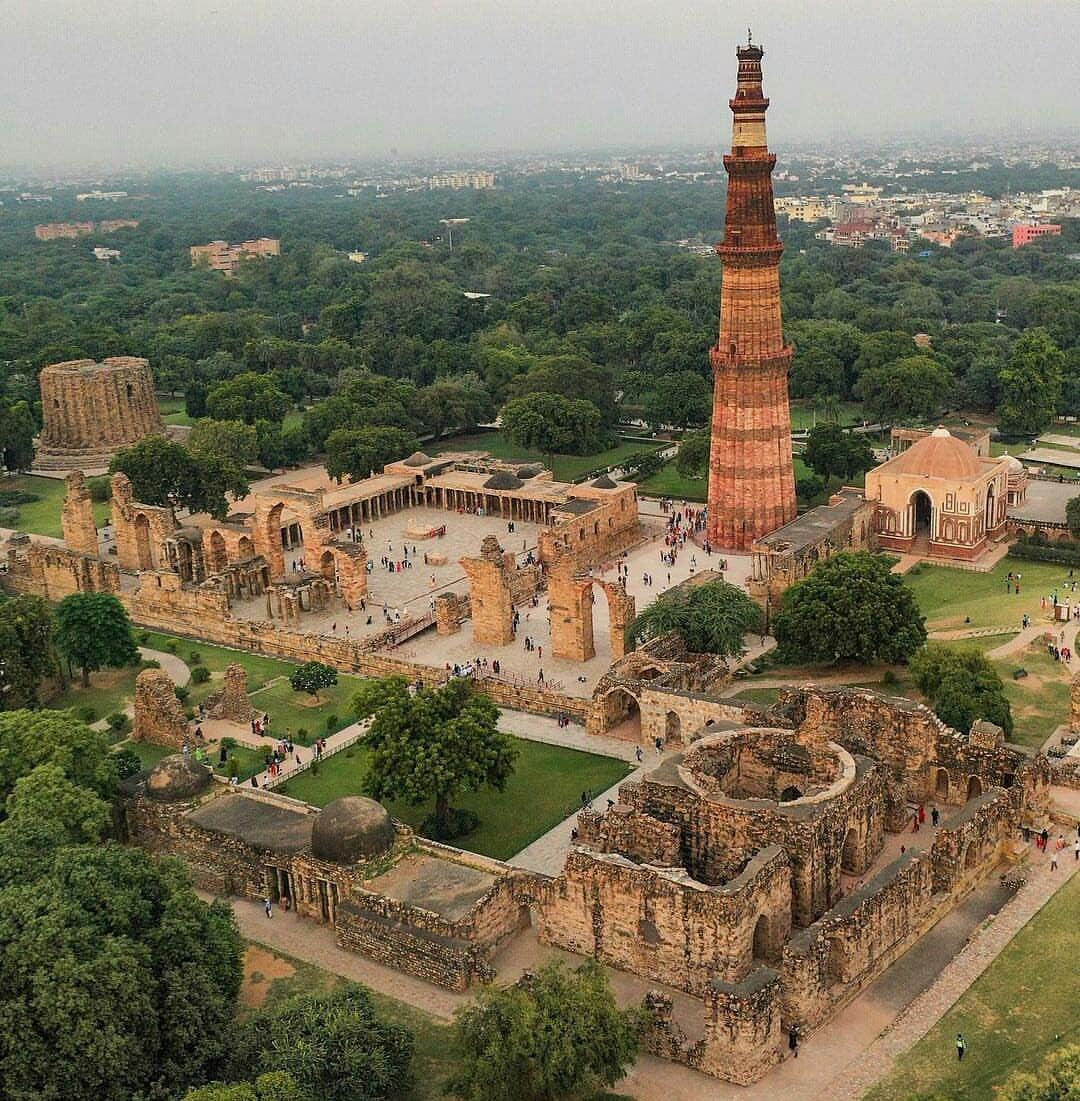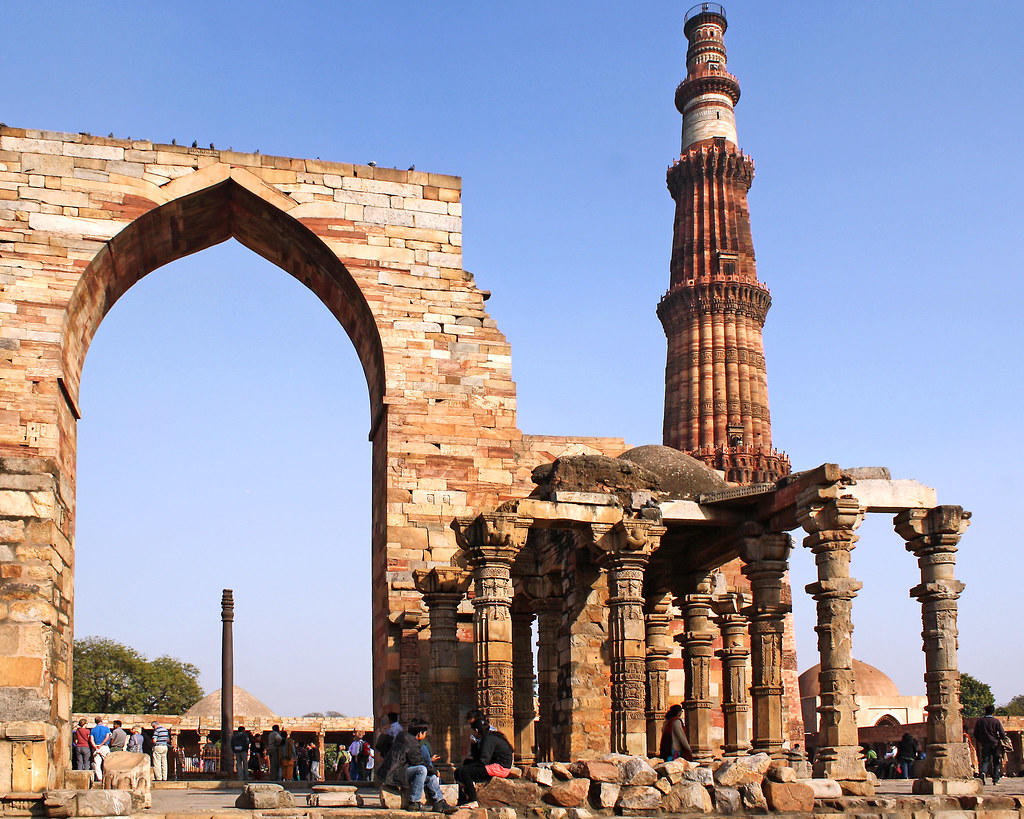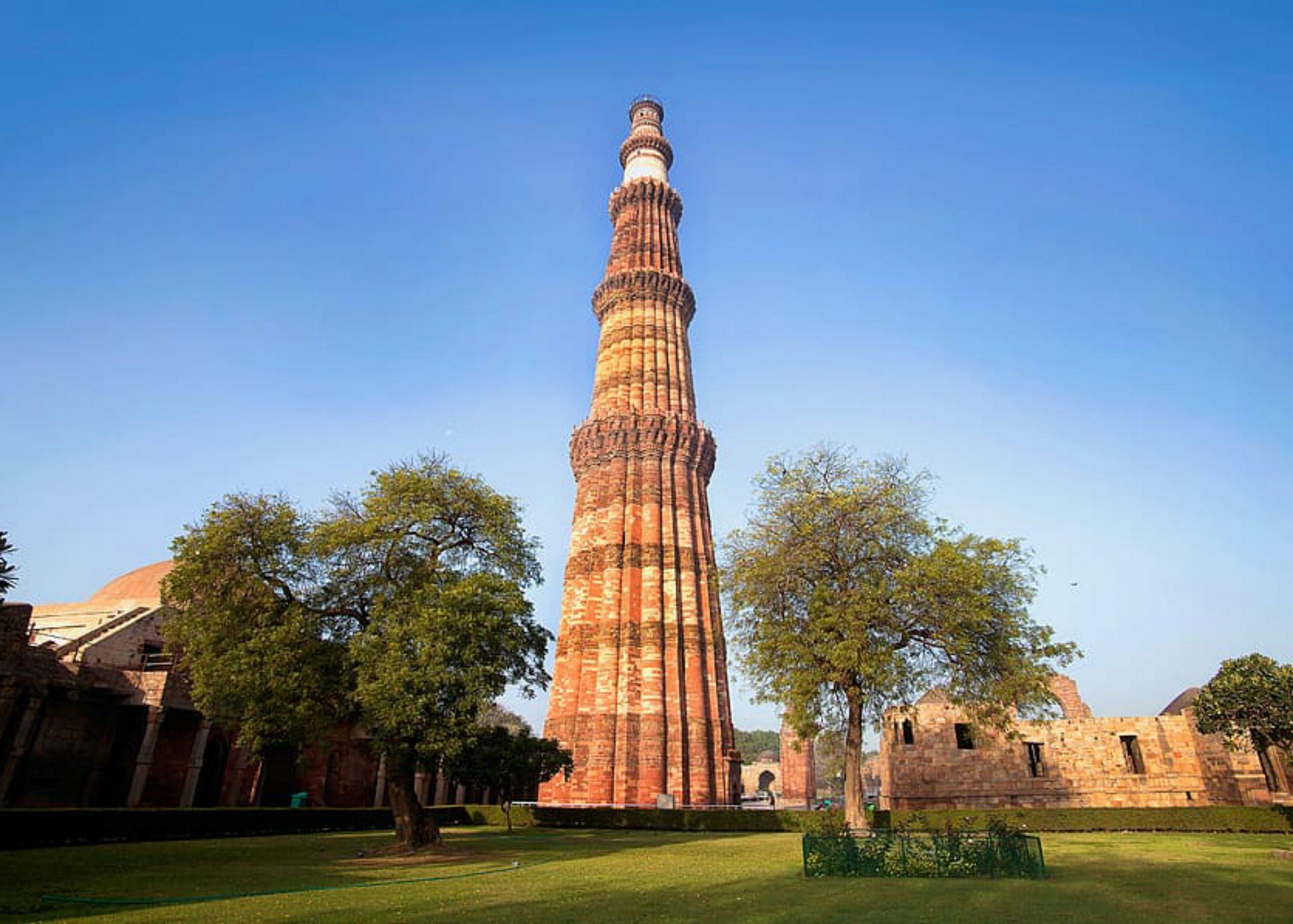The Qutub Minar is a symbol of India's rich history and culture. It is a reminder of the country's Islamic heritage and its long tradition of architectural excellence. The minaret is also a popular spot for photography and is often featured in Bollywood films.
The famous Qutab Minar, the highest brick minaret in the world, is nearly as old as the Delhi Sultanate's history and dominates the cityscape. This five-story, 73-foot tower is one of India's most remarkable historical structures and is recognized as a UNESCO World Heritage Site. The tower's fourth and fifth stories are composed of marble and sandstone, while the first three stories are constructed of red sandstone. Projecting balconies adorn each of the building's five stories.
Both artefacts from many earlier civilizations and masterpieces of Indo-Islamic art can be seen in New Delhi, India's Qutab Complex. The Qutab Minar, an elaborately adorned minaret that was constructed in the early 1200s, is its focal point. Two mosques are also part of the complex; the Quwwatu'l-Islam is the oldest mosque in northern India.
Discover the romantic history of the Taj Mahal.
In AD 1199, Qutbu'd-Din Aibak established the Minar to be used by the mu'azzin for calling prayer, and the first storey was built. Three additional storeys were later added by his successor and son-in-law, Shamsu'd-Din Iltutmish (AD 1211-36).
Delhi, the capital of India, is home to three World Heritage sites, including the Qutab Minar. Inspired by the Ghazni triumph tower, Qutab-ud-din-Aibak began building Qutab Minar in 1192 CE.
This marked the beginning of the Mamluk dynasty (1206–1290) in India. Regretfully, Qutab-ud-din-Aibak was not around to see its completion. The Quwat-ul-Islam Mosque, the first mosque ever built in India, is located at the base of the tapering tower.
The Mamluk dynasty (1206–1290) in India was founded by Qutab-ud-din Aibak, who commissioned the Qutab Minar, which is situated in the Mehrauli neighborhood of Delhi. Building on the model of the triumph tower at Ghazni, Afghanistan, started in 1192 AD, but sadly, Qutab-ud-din-Aibak did not live to see it finished.
Firoz Shah Tughlaq and Iltutmish, his successors, eventually finished the tower. The tower's construction was finished by Qutab-ud-din-Aibak's successors, Iltutmish and Firoz Shah Tughlaq. Firoz Shah added the final story, Iltutmish added three more, and Qutab-ud-din-Aibak completed the base.

Qutab Minar History
This monument was built in 1192 AD at the behest of Qutb-ud-Din Aibak, the founder of both the Mamluk Dynasty in Delhi and Turkish control in Northwest India.
Qutbuddin Bakhtiar Kaki, a Muslim Sufi mystic, saint, and scholar of the Chishti Order, was the subject of Aibak's dedication to the minaret. The origins of the minaret are the subject of various beliefs. Some say it served the muezzins who called the faithful to prayer from the minaret, while others think it was built as a tower of victory signifying the start of Muslim rule in India.
The tower's name is a matter of debate; some claim it was named for the Sufi saint Qutbuddin Bakhtiar Kaki, while others think Aibak was the inspiration.
Peek into the history of the Gateway of India and its importance for the British Empire.
In 1220, Shams-ud-din Iltutmish, the son-in-law of Aibak and Aibak's successor, recognized as the founder of the Delhi Sultanate, finished the tower. Iltutmish expanded the monument by adding three levels. A few natural disasters affected this historical landmark. In 1369 AD, lightning struck the top story of the minaret, completely removing it. Sultan Firuz Shah Tughlaq, who ruled the Sultanate of Delhi at the time, oversaw its renovation and added two further stories of marble and red sandstone to the minaret.
The Qutb Minar incorporates elements of traditional Islamic architecture and southwestern Asian design.
Elizabeth Lambourn's research in Islam Beyond Empires: Mosques and Islamic Landscapes in India and the Indian Ocean examines the spread of Islam in South Asia and its influence on Islamic religious architecture.
Muslim immigrants from the Islamic West, fleeing the Mongol Empire, settled in India and established religious centers. The Qutb Minar became a focal point for these new Muslim communities and a symbol of Islam's presence in the region.
The minaret's architecture differs significantly from the typical style of mosques in the Middle East, reflecting the influence of local architectural traditions such as Indic temples. This influence is evident in the choice of materials, construction techniques, and decorative elements used in building the Qutb Minar.
Historically, tower minarets were not common in South Asian-Islamic design until the 17th century, due to the slow adoption of the standard Middle Eastern style in India. Its separation from the main mosque also demonstrates how indigenous culture influenced the design of a structure with Middle Eastern origins.
The Qutb Minar is regarded as the "earliest and best example of a fusion or synthesis of Hindu-Muslim traditions," as stated by Ved Parkash in his essay The Qutb Minar from Contemporary and Near Contemporary Sources.
Like many mosques built in South Asia at that time, the minaret was constructed by Hindu laborers and craftsmen under the supervision of Muslim architects, resulting in a blend of Hindu and Islamic architectural styles. Because some of the craftsmen were Hindu and unfamiliar with the Quran, the inscriptions on the minaret consisted of a mix of disorganized Quranic texts and other Arabic expressions.
The top two stories of the minaret were rebuilt with marble by the then-Sultan of Delhi, Sikandar Lodi, following damage caused by an earthquake in 1505. Various minaret portions include Nagari and Parso-Arabic characters carved on them that describe the building's history.
After significant damage from a large earthquake on September 1, 1803, the minaret was once again subject to the wrath of nature. Major Robert Smith of the British Indian Army rebuilt it in 1828 and added a cupola to the top of the tower. Nonetheless, the cupola was removed from the tower and relocated to the east of it in 1848 per the orders of Henry Hardinge, 1st Viscount Hardinge, who was the Governor General of India at the time.
Travel back in time to the majestic Konark Sun Temple in Odisha.
Construction of the Minaret
The base of the 73-meter (240-foot) tapering minaret has a diameter of 14.3 meters (47 feet), while the top has a diameter of 2.7 meters (9 feet).
The minaret is six stories tall, the first three of which are built of red sandstone and the remaining three of which are made of sandstone and marble. To see a sweeping view of the city, climb the 379-step circular staircase to the summit of the tower. The minaret's bricks, which are coated in ornate iron engravings, are inscribed with passages from the Qur'an.
A projecting balcony encircling the minaret surrounds each floor of the tower, and it is held up by corbels adorned with Muqarnas, also known as honey-comb vaults, which are a sort of architecturally embellished vaulting. From the Aibak era to the Tughlak era, the architectural styles evolved throughout time, and the materials utilized in the tower's various stages of construction also noticeably varied. From 65 centimeters above the ground, the tower is slanted.
Learn the fascinating history of Charminar, Hyderabad's crowning jewel.
The Qutab Complex
It is surrounded by a variety of historically significant structures and monuments that are connected to the minaret; the entire region is a component of the Qutab complex. The structures inside the complex include the Quwwat-ul-Islam Mosque, the Iron Pillar of Delhi, the Tomb of Imam Zamin, the Tomb of Iltutmish, and Major Smith's Cupola among others.

The first mosque to be built in India is the Quwwat-ul-Islam Mosque, which is situated at the northeast base of the minaret. Aibak commissioned the mosque's construction, which was finished in 1197. The work began in 1193. This amazing construction has an inner and an outer courtyard decorated with shafts, the majority of which came from the 27 Hindu temples that were destroyed to make way for the mosque. Such information is recorded in a provocative inscription carved over the mosque's eastern gate, demonstrating the presence of traditional Hindu decor in a Muslim mosque.
The 7 m (23 ft.) Iron Pillar, a rust-resistant iron column that draws interest from tourists, archaeologists, and materials scientists, is another noteworthy item within the Qutab complex. The inscriptions on this Gupta Empire pillar are Brahmic. It is widely held that a person's desire will come true if they are able to stand with their back to the pillar and clasp it with both hands.
Travel to India's seat of political power and unravel the history of the Red Fort.
Qutab Minar Tourism
From sunrise to sunset, the Mehrauli monument complex in Delhi, India, is open to visitors.
The cost of admission is Rs. 500 for foreigners and Rs. 30 for Indian citizens per person.
Children under the age of 15 enter free of charge. The minaret's interior staircase was open for visitors to ascend, but officials restricted public access to it after a serious accident on December 4, 1981, which left 45 people dead and numerous others injured. The Qutab Minar, a masterpiece of Indian medieval architecture, has endured over time as one of the most visited tourist destinations in Delhi, India. A 360-degree traversal of the tower has been made possible by a recent partnership with the Archaeological Survey of India.
The location, shapes and patterns, materials, and content of the Qutab Minar and its monument complex are all largely real. The qualities that uphold the property's Outstanding Universal Value are accurately and believably described, effectively capturing its worth. Repairs made to the property have honoured its original architectural, ornamental, and construction systems, which attest to its Outstanding Universal Value and preserve its condition of conservation. Periodically, work is done to guarantee the property's reversible material and structural sustainability.
Enduring Legacy of Qutab Minar
The Archaeological Survey of India (ASI) is in charge of overseeing the Qutab Minar and its Monuments complex, which is owned by the Indian government. A number of entities, including the Delhi Development Authority, Municipal Corporation of Delhi, Government of the National Capital Territory of Delhi, and ASI, are in charge of managing its periphery territory.
Indian Forest Act (1927), Forest Conservation Act (1980), Delhi Development Act (1957), Land Acquisition Act (1894), Delhi Urban Art Commission Act (1973), Urban Land (Sealing and Regulation) Act (1976), Environmental Pollution Control Act (1986), Delhi Municipal Corporation Act (1957), and the Ancient Monuments and Archaeological Sites and Remains Act (1958) and its Rules (1959) govern the overall management of the property and its surrounding area. The Central Government provides yearly funding for the property's general management, conservation, and upkeep.
Revel in the history of the Ajanta Caves and celebrate India's cultural diversity.
The ASI Acts and Rules oversee, preserve, and manage the Qutab Minar and its Monuments complex through a yearly conservation and development plan. Experts, researchers, and training are enlisted to support the plan and guarantee superior conservation that upholds the property's uniqueness. The site is safeguarded in the interim by a well-established management system, despite a request to create a management plan that incorporates conservation, integrated development, visitor management, and interpretation.

Marvel at India's architectural glory through a history of the Ellora Caves.
Qutab Minar, in Delhi, is a UNESCO World Heritage Site declared in 1993. Standing tall and proud as a symbol of Indo-Islamic power and dominance, It is part of the Qutab Complex which includes the Quwat-ul-Islam Mosque, Alai Darwaza, Alai Minar, Alauddin Madrasa and Tomb, Iron Pillar, Imam Zamin’s Tomb, Sanderson’s Sundial and Major Smith’s Cupola. The Alai Minar was supposed to be the tallest minaret in the world, envisioned to be twice the size of Alauddin Khilji’s Qutab Minar, but after his death, no one fulfilled his ambition.
Trace India's spiritual roots with a history of the Khajuraho temples.
Qutab complex in Delhi is the venue of the annual three-day Qutab Festival — a gathering of musicians, artists, and dancers. Surrounded by a picturesque garden, the Qutab Minar creates a memorable scene. Tourists also come here to relax in the garden and admire the attractive look of the tower. Many of them can be seen taking pictures of this magnificent architecture to remember the experience through photos of the Qutab Minar.















